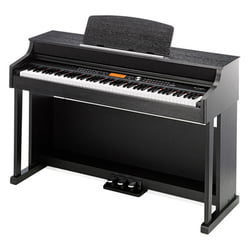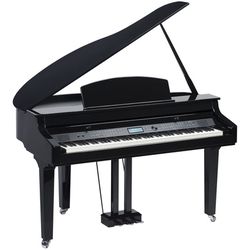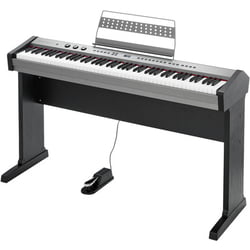What components and features does a digital piano have?
Keyboard
The construction and quality of any piano's keyboard is fundamental for the instrument's touch and playing feel.
Traditional upright and grand pianos have what is called hammer action, where a hammer strikes a string when a key is pressed. Manufacturers of digital pianos try to reproduce this characteristic playing feel in various ways, principally by equipping their high-quality digital pianos with weighted keys: A complex raft of mechanisms mimics the resistance, pressure point, and general feel of each individual key of a hammer action piano.
The keys themselves are made of plastic on inexpensive digital pianos, and of wood and synthetic ivory on higher-priced models. Their texture and feel will play an important part in your personal playing experience.
A digital piano's touch sensitivity, often called velocity sensitivity, ensures that a note sounds louder or softer depending on the intensity with which you play the keys.
The number of keys on a digital piano can vary depending on its size. Standard keyboards have 88 keys, just like an upright or grand piano.
Pedals
Traditional pianos have three pedals, and this standard setup will also be mirrored on any good electric piano. The soft pedal generates a softer sound, while the sostenuto pedal extends the notes that were being played while the pedal was depressed. Finally, the sustain pedal ensures that all notes ring out for longer. Digital pianos without their own pedals should have connections for external pedals, and even inexpensive electric pianos should at least have the option of connecting a sustain pedal.
Sound
Electric pianos use samples of real pianos as the basis for their sound, which is output via built-in speakers or headphones.
Many digital pianos have additional sounds sampled from other keyboard instruments such as the spinet or harpsichord, but also the organ or even stringed instruments.
Effects such as echo, reverb, Leslie. and more are also included with many instruments.
Polyphony
Polyphony indicates how many notes an electric piano can play simultaneously. A polyphonic piano capable of producing 128 notes (or more) should be standard you aim for; this is because, in addition to the notes currently being played, notes that are still sustaining also have to be taken into account - particularly when using a sustain pedal or when playing complicated pieces involving rapid successions of notes.
Connections
If you are planning on connecting your new digital piano to a larger sound system or a mixer, it must be equipped with a line output. Headphone and pedal connections are also a practically universal standard; also widespread is an audio- input for connecting a music device. Electric pianos with USB/MIDI connections can be updated and edited via computer: Many manufacturers offer additional sounds or functions for download, allowing you to broaden your instrument's palette. And if you frequently work with recording software using DAWs, USB/MIDI connectivity means your piano can serve as a master keyboard.
What kinds of digital piano are there, and which brands make electric pianos?
Broadly speaking, we can distinguish between standard digital pianos, digital grand pianos, compact digital pianos, and stage pianos.
Among the most noteworthy manufacturers of digital pianos are Yamaha, Thomann, Kawai, Roland, and Korg; their years of experience guarantee the authentic sounds and high-quality keyboards of their digital pianos.
The broadest spectrum when it comes to price and features is the category of standard digital pianos, ranging from a lightweight, portable instrument like the Thomann SP-320 to the ultra-high end Yamaha N-1X Avant Grand. Beginners, especially, are advised to take a look at our bundles, which also include a piano stool, headphones and stand: One quality package is the Thomann DP-28 Digital Piano Bundle.
Digital grand pianos are exquisite instruments in their own right, and offer the very highest standards with regard to both sound quality and the workmanship of their keyboards and finish. Here, too, bundles such as the Thomann DP-275 GP WHP Set combine outstanding electric grands with all the necessary accessories.
The category of compact digital pianos comprises – logically enough – lightweight, portable instruments. Some of these digital pianos are also suitable for the stage, with a range of functions that often goes far beyond what one would expect of a standard electric piano. One such multifunctional favourite is the Thomann SP-5600, a keyboard/stage piano with a battery of more than 600 sounds.
Last but not least are the stage pianos, which are of course primarily designed to be played live on stage. Brands such as Clavia, Roland, Yamaha, Kawai, and Thomann offer portable instruments with a wide range of functions, providing harmonies and melodies for every style of music. This category ranges from the phenomenally powerful flagship Clavia Nord Stage 4 88 to the many affordable Thomann models, such as the DP 26 and DP 28 Plus or the SP 120 and SP 320, which are also available as a bundle.







)
)